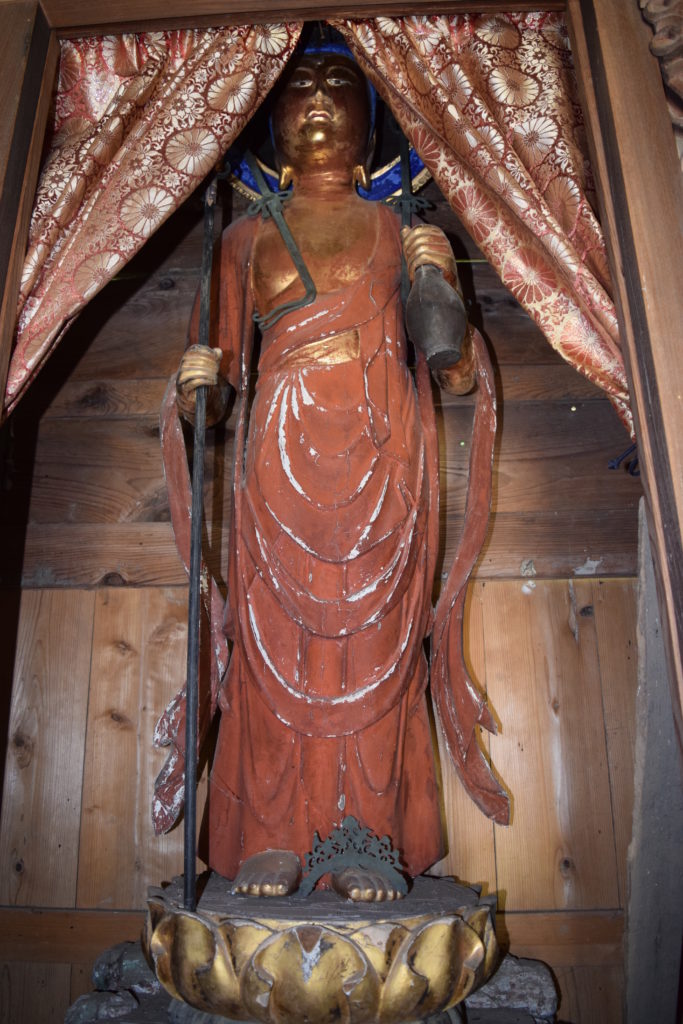Ogouchi is located next to the prefectural border with Kyoto and the eastern gateway to Tajima Province (northern part of Hyogo Prefecture).
It was once hard to access, especially in winter. But the opening of Shin-Tobi Tunnel on National Route 426 in 1998 solved the problem.
Gakuon-ji Temple

The temple, belonging to Eihei-ji School of Soto Zen sect, was established in 1595. According to a paleography, there originally used to be another temple, Saiko-ji Temple, at a different place. But after its abolishment due to devastation, Garan cathedral was rebuilt at the same place and Saiko-ji was renamed to the current name. Later, Gakuon-ji was moved here. Its principal image is Shaka Nyorai (Buddha Shakyamuni). Also, the seated Amitabha Buddha statue, which is thought to be created during the Muromachi Period, is enshrined. Many worshippers come to the Shichifukujin (Seven Deities of Good Luck) festival in autumn.
Eleven-faced Standing Kannon Statue


This statue was sculptured by Eshin Sozu and said to be established in 967 by Yoshimitsu Omiya, an imperial envoy. The wooden splendid statue is two meters tall including the seat and has crystal eyes and a circular halo. In front of the statue, there are sculptures of ascending dragon and descending dragon. The former, displayed on the left, is in the rough as it has only a part of its head.
Ruins Of Ogouchi Castle

Ogouchi Castle, built at a 400-meter elevated mountain in the Muromachi Period, was owned by Magozaemon Naito, the Kyujin (an appointee allowed to own his territory) of the Yamana Clan. The statue of Konpira is enshrined at the flat area of this mountain, where a turret was once built, to worship the mountains, and the remains of trenches can be seen on the northern side of Konpira’s shrine. The castle was located on the provincial borders with Tajima (currently in the northern Hyogo), Tanba and Tango (both are currently in the northern Kyoto) and considered one of the most important front-line bases of that age.
Monument Commemorating Inakiba’s Cows

Since the Genroku Era of the Edo Period (about the end of the 17th century), cows raised in Tajima Province had been known as the one so powerful and robust that they were suitable for agriculture. This monument was established to hand down its origin.
According to a legend, Kichiemon Inakiba raised cows with superior lineage, which were used to drag ridge poles from the area currently falling on Yabu City to then-rebuilding Sanjusangendo Temple in Kyoto.
After World War II, the newly-formed union has graded up and increased the cows, providing the foundation of improving Japanese-produced beef, or “wagyu”.
Kumano-jinja Shrine

Kumano-jinja Shrine, which prays for the health, longevity and well-being of the family, consists of two shrine halls and a dance performance hall. It is said that the shrine is descended from Kumano Hayatama Taisha Shrine in Wakayama Prefecture. Awashima-jinja Shrine, located on the left of this shrine, enshrines the guardian for women. So many female residents in Takahashi Village visited there. The annual festival is held in April.
Kotohajime (The Start Of Agricultural Affairs)


In the past, people in the community started agricultural affairs and prayed for bumper harvests on February 8 of the old lunar date. Currently, the date moves to Sunday of late February or early March. Local people make the decoration called “houki” from straw and cook rice cake with salty azuki beans sprinkled. Then, they make the offering to the deity and wine and dine together. After that, the straw decoration is hung over the river.



